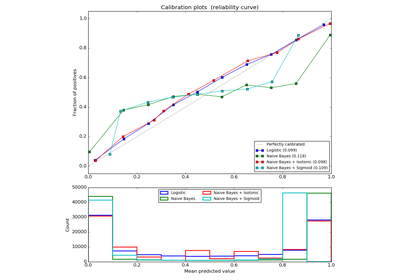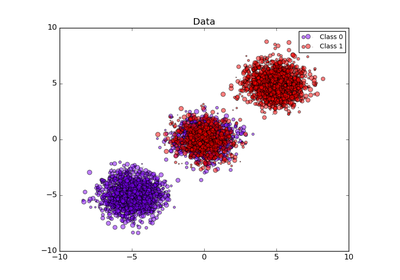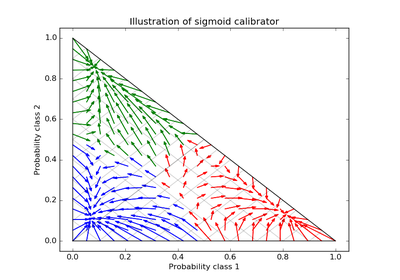sklearn.calibration.CalibratedClassifierCV¶
-
class
sklearn.calibration.CalibratedClassifierCV(base_estimator=None, method='sigmoid', cv=3)[source]¶ Probability calibration with isotonic regression or sigmoid.
With this class, the base_estimator is fit on the train set of the cross-validation generator and the test set is used for calibration. The probabilities for each of the folds are then averaged for prediction. In case that cv=”prefit” is passed to __init__, it is it is assumed that base_estimator has been fitted already and all data is used for calibration. Note that data for fitting the classifier and for calibrating it must be disjoint.
Read more in the User Guide.
Parameters: base_estimator : instance BaseEstimator
The classifier whose output decision function needs to be calibrated to offer more accurate predict_proba outputs. If cv=prefit, the classifier must have been fit already on data.
method : ‘sigmoid’ or ‘isotonic’
The method to use for calibration. Can be ‘sigmoid’ which corresponds to Platt’s method or ‘isotonic’ which is a non-parameteric approach. It is not advised to use isotonic calibration with too few calibration samples
(<<1000)since it tends to overfit. Use sigmoids (Platt’s calibration) in this case.cv : integer, cross-validation generator, iterable or “prefit”, optional
Determines the cross-validation splitting strategy. Possible inputs for cv are:
- None, to use the default 3-fold cross-validation,
- integer, to specify the number of folds.
- An object to be used as a cross-validation generator.
- An iterable yielding train/test splits.
For integer/None inputs, if
yis binary or multiclass,StratifiedKFoldused. Ifyis neither binary nor multiclass,KFoldis used.Refer User Guide for the various cross-validation strategies that can be used here.
If “prefit” is passed, it is assumed that base_estimator has been fitted already and all data is used for calibration.
Attributes: classes_ : array, shape (n_classes)
The class labels.
calibrated_classifiers_: list (len() equal to cv or 1 if cv == “prefit”) :
The list of calibrated classifiers, one for each crossvalidation fold, which has been fitted on all but the validation fold and calibrated on the validation fold.
References
[R1] Obtaining calibrated probability estimates from decision trees and naive Bayesian classifiers, B. Zadrozny & C. Elkan, ICML 2001 [R2] Transforming Classifier Scores into Accurate Multiclass Probability Estimates, B. Zadrozny & C. Elkan, (KDD 2002) [R3] Probabilistic Outputs for Support Vector Machines and Comparisons to Regularized Likelihood Methods, J. Platt, (1999) [R4] Predicting Good Probabilities with Supervised Learning, A. Niculescu-Mizil & R. Caruana, ICML 2005 Methods
fit(X, y[, sample_weight])Fit the calibrated model get_params([deep])Get parameters for this estimator. predict(X)Predict the target of new samples. predict_proba(X)Posterior probabilities of classification score(X, y[, sample_weight])Returns the mean accuracy on the given test data and labels. set_params(**params)Set the parameters of this estimator. -
fit(X, y, sample_weight=None)[source]¶ Fit the calibrated model
Parameters: X : array-like, shape (n_samples, n_features)
Training data.
y : array-like, shape (n_samples,)
Target values.
sample_weight : array-like, shape = [n_samples] or None
Sample weights. If None, then samples are equally weighted.
Returns: self : object
Returns an instance of self.
-
get_params(deep=True)[source]¶ Get parameters for this estimator.
Parameters: deep: boolean, optional :
If True, will return the parameters for this estimator and contained subobjects that are estimators.
Returns: params : mapping of string to any
Parameter names mapped to their values.
-
predict(X)[source]¶ Predict the target of new samples. Can be different from the prediction of the uncalibrated classifier.
Parameters: X : array-like, shape (n_samples, n_features)
The samples.
Returns: C : array, shape (n_samples,)
The predicted class.
-
predict_proba(X)[source]¶ Posterior probabilities of classification
This function returns posterior probabilities of classification according to each class on an array of test vectors X.
Parameters: X : array-like, shape (n_samples, n_features)
The samples.
Returns: C : array, shape (n_samples, n_classes)
The predicted probas.
-
score(X, y, sample_weight=None)[source]¶ Returns the mean accuracy on the given test data and labels.
In multi-label classification, this is the subset accuracy which is a harsh metric since you require for each sample that each label set be correctly predicted.
Parameters: X : array-like, shape = (n_samples, n_features)
Test samples.
y : array-like, shape = (n_samples) or (n_samples, n_outputs)
True labels for X.
sample_weight : array-like, shape = [n_samples], optional
Sample weights.
Returns: score : float
Mean accuracy of self.predict(X) wrt. y.
-
set_params(**params)[source]¶ Set the parameters of this estimator.
The method works on simple estimators as well as on nested objects (such as pipelines). The former have parameters of the form
<component>__<parameter>so that it’s possible to update each component of a nested object.Returns: self :




